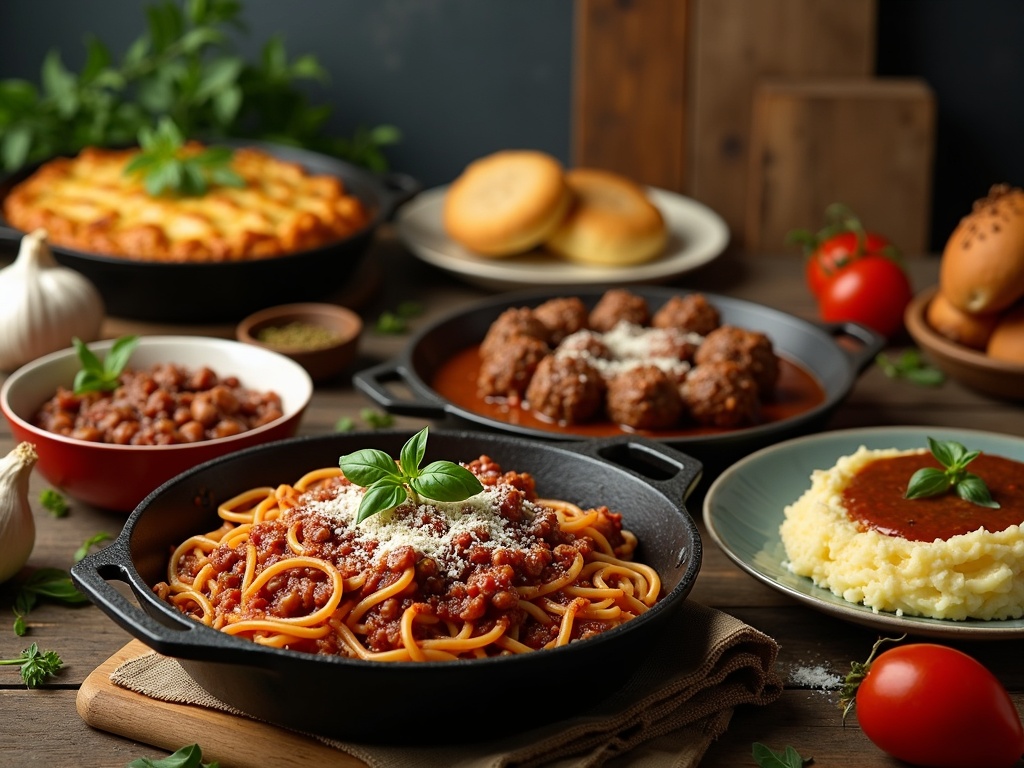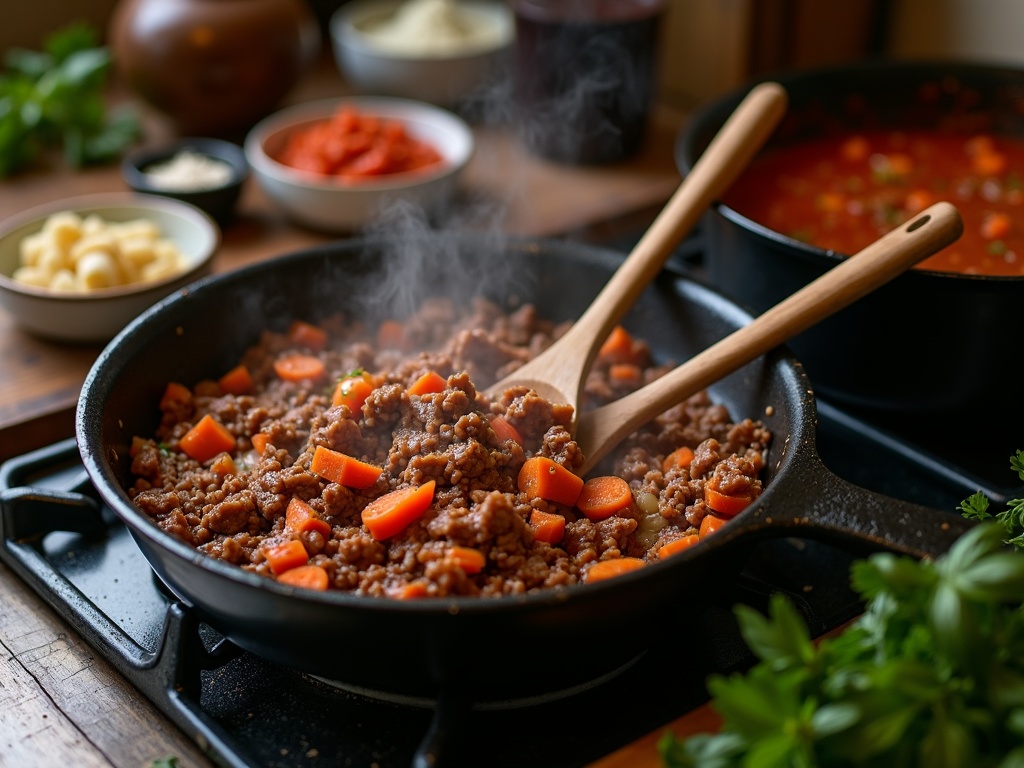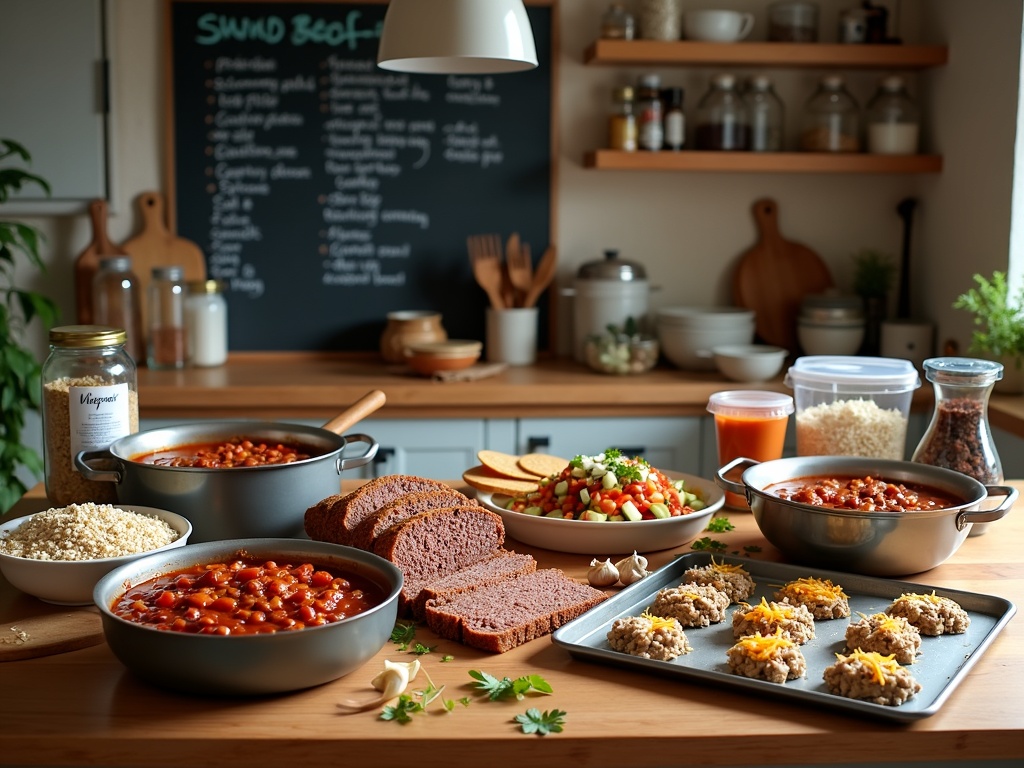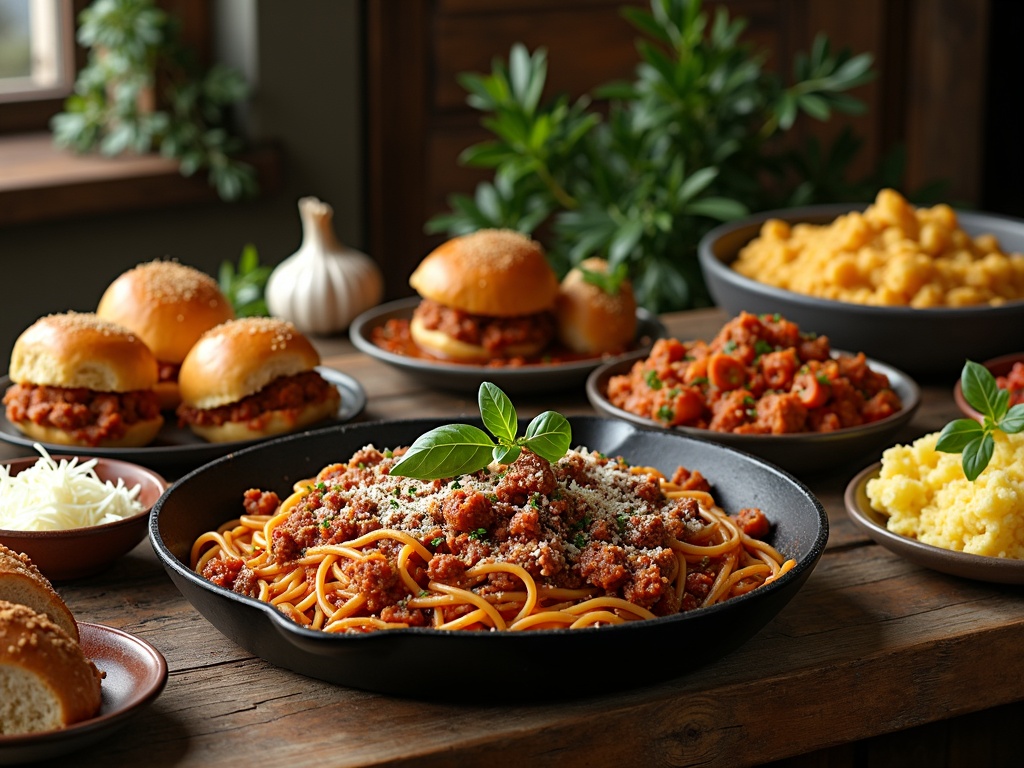Mince beef recipes offers incredible versatility in the kitchen, serving as the foundation for countless hearty and satisfying meals that can be customized to suit any palate or dietary need. Whether transformed into rich Bolognese sauce, juicy meatballs, or comforting cottage pie, this adaptable protein proves itself as an essential kitchen staple for both quick weeknight dinners and special occasions.
Find In This Article
Key Takeaways
- The quality of your dish begins with proper meat selection—80/20 ground beef provides good flavor for most recipes, while leaner 90/10 works best when fat will drain away during cooking.
- Properly browning mince beef is crucial for developing deep flavors; avoid overcrowding the pan and allow the meat to develop a caramelized crust before breaking it apart.
- Extending ground beef with ingredients like breadcrumbs, oats, or finely diced vegetables not only makes it more economical but can add nutrition and moisture to your dishes.
- Freezing prepared ground beef dishes in portions creates a convenient meal-prep strategy that saves time and money while ensuring homemade meals are always within reach.
- Complementary side dishes can transform simple mince beef meals—consider pairing with fresh salads for textural contrast or traditional starches like mashed potatoes to absorb flavorful sauces.
Simple and Delicious Mince Beef Staples
I’ve discovered that mince beef (or ground beef as it’s known in some places) is one of the most versatile ingredients in my kitchen. When I’m short on time but still want something satisfying, I turn to these classic ground beef staples that never disappoint.
Family Favorites That Never Fail
Classic beef mince with tomato sauce forms the foundation of countless meals. I start by browning the mince in a hot pan, then add diced onions, garlic, and a can of quality tomatoes. The secret is letting it simmer until the flavors meld together. This basic combination can be:
- Transformed into tacos
- Served over rice
- Used as a base for more complex dishes
Hearty cottage pie ranks high on my comfort food list. The key is cooking the mince with carrots, celery, and peas in a rich gravy before topping it with fluffy mashed potatoes. I always create ridges in the potato topping with a fork before baking – it creates those perfect crispy edges everyone fights over.
For a meal that pleases everyone, traditional spaghetti bolognese is unbeatable. I enhance my sauce with a splash of red wine and let it simmer for at least an hour. The longer it cooks, the better the flavor develops. A sprinkle of fresh basil and grated Parmesan brings it all together.
Homemade meatballs offer endless possibilities. I mix mince beef with breadcrumbs, an egg, chopped herbs, and grated onion. The trick to juicy meatballs is not overworking the mixture and cooking them gently. These can be:
- Simmered in tomato sauce for a classic Italian meal
- Added to soups
- Transformed into amazing meatball sliders for a perfect party appetizer
When I’m craving something heartier with a kick, homemade chili hits the spot. The combination of beef mince, beans, and warming spices creates a meal that improves over time, making it perfect for batch cooking.
For a quick weeknight dinner that’s both comforting and simple, I often prepare ground beef with gravy served over mashed potatoes. The savory gravy mixed with perfectly cooked ground beef creates a dish that’s greater than the sum of its parts.
These classics have earned their place in my regular rotation because they’re reliable, adaptable, and always satisfy. With just a few pantry staples and some quality beef mince, I’ve got the foundation for a week’s worth of varied and delicious meals.

Essential Ingredients for Basic Mince Beef
Starting with quality ingredients makes all the difference when preparing delicious ground beef recipes. I’ve found that keeping a few staples on hand lets me create fantastic meals with minimal fuss. Whether I’m making a quick weeknight dinner or planning something special, these core ingredients form the foundation of most mince beef dishes.
Core Components for Flavorful Results
Fresh lean ground beef sits at the center of any good mince recipe. For everyday cooking, I prefer 80/20 ground beef (80% lean meat, 20% fat), which offers enough fat to keep dishes juicy and flavorful without becoming greasy. While leaner options like 90/10 work well for recipes where fat drains away, such as in homemade chili recipes, they can become dry in other applications. The quality matters too—bright red meat with a fresh smell indicates prime condition.
Onions and garlic provide the aromatic base for almost every mince beef dish I create. Yellow or white onions offer reliable flavor for everyday cooking, while shallots can add a more delicate touch to bolognese sauce or fancier preparations. Fresh garlic brings an irreplaceable depth that garlic powder can’t match, though the powder works in a pinch. I’ve found that finely dicing these aromatics helps them melt into the meat for even distribution of flavor.
Basic seasonings transform simple mince into something special. My go-to combination includes:
- Salt and freshly ground black pepper (the foundation of all seasoning)
- Worcestershire sauce (adds umami depth perfect for mini meatball sliders)
- Paprika (brings color and subtle sweetness)
- Cumin (adds earthiness, especially good in Tex-Mex dishes)
- Red pepper flakes (for controllable heat)
Fresh herbs elevate mince beef dishes from good to remarkable. Parsley works in almost anything, adding brightness without overpowering. Thyme and rosemary pair beautifully with beef in more rustic preparations like beef and gravy over mashed potatoes. Oregano and basil shine in Mediterranean-inspired dishes. I typically add woody herbs like thyme early in cooking, while saving tender herbs like parsley for the finish.
The way you cook your ground beef matters as much as the ingredients. I’ve learned to avoid overcrowding the pan, which causes steaming instead of browning. Browning creates those delicious caramelized bits that form the flavor foundation of many dishes. For most recipes, I brown the meat first, remove it, sauté the aromatics in the same pan, then return the meat to combine the flavors.
Liquids also play an important role in developing flavor. Depending on the recipe, I might add:
- Beef broth (enhances meaty flavor)
- Red wine (adds depth and acidity)
- Tomato paste (concentrates umami and adds richness)
- Soy sauce (brings savory notes without obvious Asian flavor)
Texture elements often get overlooked but can transform a dish. Breadcrumbs help bind mixtures for meatballs or meatloaf, while cornstarch creates silky thickness in sauces. Eggs serve as both binder and moisture-keeper in formed mince dishes.
These fundamental ingredients give me endless possibilities with ground beef. By keeping them stocked, I’m always ready to create something delicious without a special shopping trip.
Preparing Your Mince Beef Like a Pro
Getting the perfect texture and flavor from your mince beef begins with proper preparation techniques. I’ve found that mastering a few simple steps can transform your ground beef dishes from ordinary to exceptional. Let’s explore how to prep your mince beef like a professional chef.
Mastering the Browning Process
Browning mince beef properly creates that delicious caramelized flavor that forms the foundation of many recipes. The secret is to start with a hot pan – preferably cast iron or stainless steel. Heat the pan first, then add a small amount of oil with a high smoke point like vegetable or avocado oil.
Don’t overcrowd the pan! Working in batches might take longer, but it’s worth it. When too much meat is added at once, it releases moisture that steams rather than browns the meat. I add about 1 pound (450g) at a time to a large skillet.
Let the meat sit undisturbed for about 4-5 minutes before stirring. This initial contact creates the Maillard reaction – that beautiful browning that equals flavor. After the first flip, I break up the meat using a wooden spoon or potato masher for even cooking.
For recipes like flavorful Bolognese sauce or hearty chili, proper browning makes all the difference in developing deep, rich flavors.
Perfecting Texture and Fat Content
Breaking up the meat evenly ensures consistent cooking and better texture in your finished dish. I’ve found several effective methods:
- Use a potato masher for quick, even breakdown
- Try a wooden spoon with a straight edge to chop while stirring
- Consider a ground meat chopper tool designed specifically for this purpose
- For very fine texture (ideal for mini meatball sliders), pulse in a food processor before cooking
Draining excess fat is crucial for many recipes, especially healthier options. After browning, tilt the pan slightly and spoon out the rendered fat, or transfer the meat to a colander lined with paper towels. For recipes like ground beef and gravy, you might want to keep some fat for flavor.
For leaner results, rinse the cooked meat with hot water and drain well – though this will remove some flavor along with the fat. If your recipe needs moisture, you can add beef broth back in later.
The timing of aromatics can make or break your dish. I add onions after the meat has browned about 75%, allowing them to cook in the remaining fat for about 3-4 minutes until translucent. Garlic goes in last – just 30 seconds before removing from heat or adding liquid ingredients – to prevent burning and bitterness.
For complex flavor development, add harder aromatics (like carrots and celery) alongside onions, and delicate herbs near the end. When cooking ground beef for multiple uses, keep seasonings minimal during the initial cooking, then customize portions later for specific recipes.
The fat content in ground beef serves as both flavor carrier and moisture provider. For juicier burgers or meatballs, an 80/20 lean-to-fat ratio works beautifully, while leaner 90/10 might be better for dishes where the meat will be drained.
By applying these professional techniques, you’ll create restaurant-quality results with your mince beef every time – whether you’re making a quick weeknight dinner or preparing for a special occasion.
Common Mince Beef Cooking Mistakes
I’ve noticed many home cooks struggle with the same issues when preparing delicious mince beef dishes. Even simple mistakes can turn what should be a flavorful meal into something less appetizing. Let me share some common pitfalls to avoid when cooking with this versatile ingredient.
Preparation Errors That Affect Flavor
Overcrowding the pan is perhaps the most frequent mistake I see. When too much mince is added to the pan at once, the meat steams rather than browns. This happens because the temperature drops significantly, and the released moisture can’t evaporate quickly enough. For best results, I cook mince in batches if needed, giving each portion enough space to develop that delicious caramelized crust.
Under-seasoning is another critical error that leaves ground beef recipes tasting flat. Mince beef needs proper seasoning to enhance its natural flavors. I always add salt and pepper at the beginning of cooking, then taste and adjust before finishing the dish. This simple step makes a world of difference in recipes like homemade chili or classic bolognese sauce.
Skipping the browning step can rob your dishes of depth and complexity. When making ground beef and gravy or similar comfort foods, I take the time to properly brown the meat until it develops a rich color. This crucial process creates the Maillard reaction, which produces compounds that give meat its savory, complex flavor profile.
Technical Missteps to Avoid
Not draining excess fat can leave dishes greasy and unhealthy. While some fat is needed for flavor, too much can make dishes like mini meatball sliders soggy and overly heavy. I typically drain off excess fat after browning unless the recipe specifically calls for it to remain.
Here are other common mistakes to watch for:
- Cooking at too high a temperature, causing the meat to burn before it’s cooked through
- Breaking up the meat too much during cooking, resulting in a mushy texture
- Adding cold ingredients directly to hot mince, which can halt the cooking process
- Using the wrong fat content for your specific recipe needs
- Rushing the cooking process, particularly with sauces that need time to develop flavor
Taking care to avoid these common errors can transform your everyday mince beef dishes from good to exceptional, allowing the true flavor of this kitchen staple to shine through in every bite.
Smart Tips for Better Mince Beef Dishes
I’ve discovered that making truly outstanding mince beef dishes isn’t just about following recipes—it’s about mastering techniques that enhance flavor and texture. These simple but game-changing tips will elevate your everyday mince beef cooking from average to exceptional.
Key Techniques for Perfect Mince Every Time
Season meat before cooking for maximum flavor development. This might seem obvious, but the timing matters significantly. I always season my mince beef right before it hits the pan, not minutes or hours ahead. Salt draws moisture from the meat, and if applied too early, you’ll end up steaming rather than browning your beef. A simple combination of salt and freshly ground black pepper works wonders, but don’t be afraid to add garlic powder, onion powder, or smoked paprika for depth.
Use high heat for proper browning—this step creates the foundation for dishes like rich Bolognese sauce or hearty homemade chili. I avoid overcrowding the pan, cooking in batches if needed to maintain temperature. When mince beef is crowded, it releases moisture that can’t evaporate quickly enough, causing it to steam instead of sear. Those gorgeous brown bits that form on the bottom of the pan? That’s called fond—it’s packed with flavor that will transform your dish.
When cooking ground beef properly, I break it apart with a wooden spoon or spatula as it cooks, creating smaller, even pieces. For dishes like mini meatball sliders, I handle the meat minimally to avoid tough results.
Add vegetables gradually based on their cooking times. I start with onions until translucent, followed by carrots and celery, then quick-cooking items like garlic or peppers last. This layering method ensures each ingredient cooks perfectly without anything becoming mushy or burnt. For a comforting ground beef gravy, perfectly cooked vegetables provide body and flavor without competing with the meat.
Let flavors develop by simmering your dish longer than you might think necessary. Many mince beef recipes taste significantly better after flavors have had time to meld. I often cook a dish like chili or Bolognese one day before I plan to serve it, allowing it to rest overnight in the refrigerator. The difference in taste is remarkable—the spices bloom, the sauce thickens naturally, and the meat becomes more tender.
For optimal results, consider these practical tips when preparing your next mince beef dish:
- Choose the right fat content for your recipe (higher fat content for burgers, leaner for saucy dishes)
- Deglaze the pan with wine, stock, or even water to capture all the flavorful browned bits
- Add umami boosters like Worcestershire sauce, soy sauce, or tomato paste
- Balance acidity with a small amount of sugar or honey if needed
- Finish with fresh herbs just before serving for brightness
By implementing these straightforward techniques, I’ve dramatically improved my everyday cooking. Even simple dishes like spaghetti Bolognese or taco meat have transformed into meals that family and friends consistently praise. The beauty of these tips is their simplicity—small adjustments that create noticeably better results without adding complexity to your cooking process.

Storing and Freezing Guidelines
Raw ground beef requires careful handling to maintain its freshness and prevent foodborne illness. Proper storage extends its shelf life and preserves its quality for your next delicious ground beef meal. Let me guide you through the essential practices for storing and freezing your mince.
Refrigeration and Freezing Best Practices
When refrigerating ground beef, I keep it in its original packaging if I’m planning to use it within a day of purchase. For longer refrigeration, I transfer it to an airtight container or wrap it tightly in plastic wrap to prevent air exposure. The meat should always be stored on the lowest shelf of your refrigerator where the temperature is coldest, ideally at 40°F (4°C) or below. This placement also prevents any potential drips from contaminating other foods.
Raw ground beef only lasts 1–2 days in the refrigerator before quality begins to deteriorate. If you can’t use it within this timeframe, freezing is your best option.
For freezing ground beef effectively, I follow these key steps:
- Remove the meat from grocery store packaging and rewrap in heavy-duty aluminum foil, plastic wrap, or freezer paper
- Place wrapped meat inside a freezer-safe ziplock bag to prevent freezer burn
- Press out as much air as possible before sealing the bag
- Label packages with the date of freezing to track storage time
- Spread meat flat in packaging before freezing for quicker thawing later
Ground beef can be safely kept frozen for 3–4 months while maintaining good quality. While it remains safe to eat beyond this period, you might notice diminished flavor and texture.
When it comes to thawing ground beef, safety is paramount. I always use one of these three methods:
- Refrigerator thawing: The safest method, requiring about 24 hours for one pound of ground beef
- Cold water thawing: Place sealed meat in cold water, changing water every 30 minutes (approximately 1 hour per pound)
- Microwave thawing: Use your defrost setting, but cook immediately afterward as parts of the meat may begin to cook during this process
Never thaw ground beef on the counter at room temperature, as this allows bacteria to multiply rapidly in the outer layers while the center remains frozen.
Once thawed, cooked ground beef can be refrigerated for 3–4 days or refrozen, though there may be some moisture loss affecting the texture. I often cook large batches of ground beef and portion them for freezing, which makes meal prep for dishes like homemade bolognese sauce or hearty chili much faster.
For cooked ground beef dishes like mini meatball sliders or beef and gravy over mashed potatoes, I store leftovers in shallow, airtight containers to help them cool quickly. Cooked ground beef dishes can typically be refrigerated for 3–4 days or frozen for 2–3 months.
I’ve found portioning ground beef before freezing extremely helpful—separating a large package into 1/2 pound or 1 pound portions lets me thaw only what I need for a specific recipe. For even more convenience, I sometimes pre-form burger patties or meatballs before freezing, separating layers with parchment paper to prevent sticking.
These storage practices not only extend the life of your ground beef but also ensure you’re ready to create delicious meals at a moment’s notice while maintaining proper food safety standards.

Health and Nutrition Considerations
Choosing the right ground beef can make a significant difference in your meals’ nutritional profile. I’ve found that selecting leaner options is a great starting point for healthier ground beef dishes without sacrificing flavor.
Smart Choices for Healthier Meals
When shopping for ground beef, pay attention to the lean-to-fat ratio. The percentage indicates how much lean meat versus fat is in your purchase:
- 90/10 or 93/7 (extra-lean): Perfect for recipes where you can’t drain fat easily
- 85/15 (lean): Offers good flavor while keeping fat content reasonable
- 80/20 (standard): More flavorful but higher in fat – best when you can drain excess fat
Portion control plays a crucial role in maintaining a balanced diet. A standard serving of ground beef should be about 3–4 ounces (the size of a deck of cards). I’ve learned that measuring portions before cooking helps prevent overindulgence, especially when making crowd-pleasers like homemade chili or pasta dishes.
Adding vegetables to your ground beef recipes significantly boosts nutritional value. When making bolognese sauce, I add finely diced carrots, celery, and bell peppers to increase fiber and vitamins. For dishes like ground beef with gravy, consider mixing in mushrooms – they blend perfectly with the meat’s texture while adding nutrients and reducing overall calories.
For those with dietary restrictions, several alternatives work well:
- Turkey or chicken mince: Leaner options with similar versatility
- Plant-based grounds: Made from soy, pea protein, or other plant sources
- Lentils: Great in dishes where the meat is mixed with other ingredients
When preparing mini meatball sliders or similar dishes, consider using half ground beef and half of an alternative to reduce fat content while maintaining familiar flavors.
Cooking techniques also impact nutritional value. I recommend taking time to properly cook ground beef by browning it thoroughly and draining excess fat. Using a colander to drain cooked ground beef can remove up to 50% of the fat content, making even standard 80/20 ground beef a healthier option.
By making thoughtful choices about the type of ground beef, portion sizes, and complementary ingredients, you can enjoy these versatile recipes as part of a balanced diet without compromising on taste or satisfaction.
Budget-Friendly Meal Ideas
I’ve discovered that ground beef is one of the most versatile and cost-effective proteins available. When money’s tight but you still want delicious, satisfying meals, ground beef recipes can be your best friend. Let me share some practical ways to make your food budget stretch further without sacrificing flavor.
Smart Strategies for Economic Cooking
Bulk cooking has saved me countless hours and dollars over the years. By preparing larger batches of dishes like hearty Bolognese sauce, I can divide portions into containers for quick weeknight dinners. This approach reduces the per-serving cost and minimizes the electricity or gas used for cooking multiple meals.
When planning bulk cooking sessions, I focus on these budget-friendly options:
- Meatloaf that can be sliced and frozen for future sandwiches
- Taco meat prepared in large batches for multiple Mexican-inspired meals
- Homemade chili that tastes even better after freezing and reheating
- Meat sauce that works for pasta, lasagna, or even pizza topping
- Mini meatballs frozen raw on baking sheets before bagging for quick meal additions
Stretching ingredients is another key technique in budget cooking. I’ve found that adding oats, breadcrumbs, or grated vegetables to ground beef extends its volume while adding nutrition. For example, mixing finely diced mushrooms or grated zucchini into burger patties not only makes the meat go further but also adds moisture and nutrients.
Economic meal planning starts with knowing which dishes deliver the most value. Ground beef with gravy over mashed potatoes is a perfect example—it’s filling, comforting, and costs just a few dollars to feed a family of four.
I make my food budget stretch even further with these practical tips:
- Buy ground beef in larger quantities when on sale, then portion and freeze
- Incorporate beans, lentils, or rice to extend ground beef in casseroles and skillet meals
- Use strongly flavored ingredients like onions, garlic, and spices to make smaller amounts of meat satisfy
- Repurpose leftovers creatively—yesterday’s taco meat becomes today’s stuffed peppers
- Plan meals that share ingredients to minimize waste and maximize purchases
Seasonal meal planning has also helped me save significantly. I adjust my cooking based on what vegetables are in season and affordable. Summer zucchini and peppers make excellent additions to ground beef skillet meals, while winter root vegetables create hearty stews with minimal meat.
I’ve found that investing in quality storage containers pays off quickly. Proper freezer storage prevents freezer burn and ensures my bulk-cooked meals maintain their flavor for months. I label everything with contents and dates using masking tape and a marker—this simple system prevents mystery meals and reduces waste.
Perhaps the biggest money-saver is developing a rotating menu of family favorites. By cycling through 10-15 reliable ground beef recipes, I can shop more efficiently, take advantage of sales, and avoid the last-minute takeout that destroys food budgets. My family gets meals they love, and I get the satisfaction of stretching our food dollars further than I ever thought possible.
With these budget-friendly approaches, ground beef becomes more than just an economical protein—it becomes the foundation for a strategic approach to feeding your family well for less.

Best Side Dishes to Serve
I’ve found that the perfect side dish can elevate a simple mince beef meal into something truly special. After creating numerous ground beef dishes over the years, I’ve discovered certain accompaniments that consistently impress dinner guests while balancing the rich flavors of beef.
Traditional Pairings That Never Disappoint
Mince beef has long-standing partnerships with certain sides that have stood the test of time. These classic combinations work because they complement rather than compete with the savory depth of properly cooked ground beef.
Mashed potatoes remain a timeless favorite, especially when serving ground beef with gravy. The creamy texture creates the perfect canvas for soaking up those rich meat juices. For the best results, add a touch of garlic and butter to your potatoes.
Dinner rolls or crusty bread make excellent companions to soak up sauces from dishes like hearty bolognese. A garlic bread variant can add another dimension of flavor to your meal.
Yorkshire puddings, while traditionally paired with roast beef, can work wonderfully with mince dishes that feature gravy or sauce components. Their airy texture and crisp exterior provide a delightful contrast.
Fresh and Creative Sides
Beyond the classics, I’ve found that thoughtfully prepared vegetable sides and creative starches can transform a mince beef meal into something special.
For vegetable options, consider:
- Roasted carrots and parsnips glazed with honey and thyme
- Steamed green beans tossed with toasted almonds and lemon zest
- Grilled asparagus drizzled with balsamic reduction
- Sautéed brussels sprouts with bacon bits (particularly good with homemade chili)
- Roasted cauliflower with parmesan and herbs
When it comes to starch accompaniments, these options pair beautifully with mince:
- Sweet potato fries dusted with smoked paprika
- Buttered egg noodles with fresh herbs
- Wild rice pilaf with mushrooms
- Polenta rounds, crispy on the outside and creamy within
- Potato dauphinoise for special occasions
Fresh salads provide a crisp contrast to rich mince beef dishes, particularly mini meatball sliders or tacos. I’ve had great success with:
- Watermelon, feta and mint salad
- Cucumber and dill with a yogurt dressing
- Classic coleslaw with a vinegar-based dressing
- Tomato and red onion salad with basil
- Arugula with lemon and parmesan
The acid in these fresh salads cuts through the richness of mince beef, creating a balanced meal that feels complete.
I’ve found that the best approach is to consider the specific mince beef dish I’m serving. Lighter preparations like beef lettuce wraps call for lighter sides, while heartier dishes like shepherd’s pie might need just a simple vegetable.
Temperature contrast also plays an important role – hot mince dishes often pair wonderfully with cool, crisp salads. The textural difference between tender, savory mince and crunchy fresh vegetables creates an enjoyable dining experience.
For family-style service, I like to offer a combination of at least one vegetable side and one starch option. This provides a balanced plate and accommodates different preferences. When hosting guests, three sides – typically a starch, a cooked vegetable, and a fresh component – create a spread that feels abundant without being overwhelming.
Remember that the best side dishes should complement your main dish without stealing the spotlight. With these versatile options, you’ll discover countless ways to enhance your mince beef creations.
Customizing Your Mince Beef Dishes
Transforming a basic ground beef recipe into something extraordinary doesn’t require culinary school training—just a willingness to experiment with flavors and ingredients. I’ve discovered that mince beef serves as an excellent canvas for creativity in the kitchen, adapting beautifully to different cuisines and dietary needs.
Flavor Explorations and Adaptations
Spice variations can completely transform your mince beef dishes. For Mediterranean flair, I mix in oregano, basil, garlic, and a splash of red wine before simmering. Mexican-inspired dishes pop with cumin, chili powder, oregano, and fresh cilantro—perfect for homemade chili with a kick. Asian-infused dishes benefit from ginger, garlic, soy sauce, and five-spice powder, creating complex flavor profiles that elevate simple ingredients.
Regional adaptations showcase how versatile mince beef truly is across global cuisines:
- Italian cooking transforms ground beef into classic Bolognese sauce with tomatoes, herbs, and a touch of dairy
- Greek-style dishes incorporate mint, oregano, and cinnamon for moussaka or stuffed vegetables
- American comfort food shines in ground beef with gravy over potatoes
- Middle Eastern cuisine features spices like allspice, cinnamon, and sumac in kofta or stuffed vegetables
I’ve had great success modifying recipes for different dietary needs. Low-carb dieters can substitute cauliflower rice in stuffed peppers, while those reducing fat can opt for leaner mince (90/10) and drain excess fat after cooking ground beef. For gluten-free options, I use tamari instead of soy sauce and ensure all spice blends are certified gluten-free.
Making mince beef dishes kid-friendly doesn’t mean sacrificing flavor. Mini meatball sliders are always a hit with little ones, especially when they help form the meatballs. Hiding finely chopped vegetables in bolognese sauce or tacos adds nutrition without complaints. I’ve learned that involving children in customizing their own taco plates or burger toppings increases their enthusiasm for dinner time.
The beauty of working with mince beef lies in its ability to take on whatever personality you give it—from spicy and bold to subtle and comforting. Each variation creates an entirely new experience from the same humble starting ingredient.

